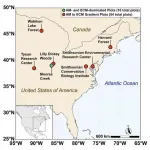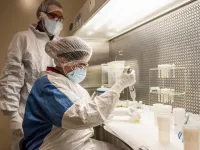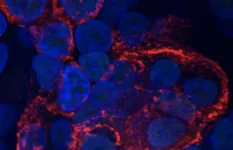Automated AI algorithm uses routine imaging to predict cardiovascular risk
Artificial intelligence deep learning system can automatically measure coronary artery calcium from routine CT scans and predict cardiovascular events like heart attacks
2021-01-29
(Press-News.org) Coronary artery calcification -- the buildup of calcified plaque in the walls of the heart's arteries -- is an important predictor of adverse cardiovascular events like heart attacks. Coronary calcium can be detected by computed tomography (CT) scans, but quantifying the amount of plaque requires radiological expertise, time and specialized equipment. In practice, even though chest CT scans are fairly common, calcium score CTs are not. Investigators from Brigham and Women's Hospital's Artificial Intelligence in Medicine (AIM) Program and the Massachusetts General Hospital's Cardiovascular Imaging Research Center (CIRC) teamed up to develop and evaluate a deep learning system that may help change this. The system automatically measures coronary artery calcium from CT scans to help physicians and patients make more informed decisions about cardiovascular prevention. The team validated the system using data from more than 20,000 individuals with promising results. Their findings are published in Nature Communications.
"Coronary artery calcium information could be available for almost every patient who gets a chest CT scan, but it isn't quantified simply because it takes too much time to do this for every patient," said corresponding author Hugo Aerts, PhD, director of the Artificial Intelligence in Medicine (AIM) Program at the Brigham and Harvard Medical School. "We've developed an algorithm that can identify high-risk individuals in an automated manner."
Working with colleagues, lead author Roman Zeleznik, MSc, a data scientist in AIM, developed the deep learning system described in the paper to automatically and accurately predict cardiovascular events by scoring coronary calcium. While the tool is currently only for research purposes, Zeleznik and co-authors have made it open source and freely available for anyone to use.
"In theory, the deep learning system does a lot of what a human would do to quantify calcium," said Zeleznik. "Our paper shows that it may be possible to do this in an automated fashion."
The team began by training the deep learning system on data from the Framingham Heart Study (FHS), a long-term asymptomatic community cohort study. Framingham participants received dedicated calcium scoring CT scans, which were manually scored by expert human readers and used to train the deep learning system. The deep learning system was then applied to three additional study cohorts, which included heavy smokers having lung cancer screening CT (NLST: National Lung Screening Trial), patients with stable chest pain having cardiac CT (PROMISE: the Prospective Multicenter Imaging Study for Evaluation of Chest Pain), and patients with acute chest pain having cardiac CT (ROMICAT-II: the Rule Out Myocardial Infarction using Computer Assisted Tomography trial). All told, the team validated the deep learning system in over 20,000 individuals.
Udo Hoffmann, MD, director of CIRC@MGH who is the principal investigator of CT imaging in the FHS, PROMISE and ROMICAT, emphasized that one of the unique aspects of this study is the inclusion of three National Heart, Lung, and Blood Institute-funded high-quality image and outcome trials that strengthen the generalizability of these results to clinical settings.
The automated calcium scores from the deep learning system highly correlated with the manual calcium scores from human experts. The automated scores also independently predicted who would go on to have a major adverse cardiovascular event like a heart attack.
The coronary artery calcium score plays an important role in current guidelines for who should take a statin to prevent heart attacks. "This is an opportunity for us to get additional value from these chest CTs using AI," said co-author Michael Lu, MD, MPH, director of artificial intelligence at MGH's Cardiovascular Imaging Research Center. "The coronary artery calcium score can help patients and physicians make informed, personalized decisions about whether to take a statin. From a clinical perspective, our long-term goal is to implement this deep learning system in electronic health records, to automatically identify the patients at high risk."
INFORMATION:
Funding for this work was provided by the National Institutes of Health (NIH-USA U24CA194354, NIHUSA U01CA190234, NIH-USA U01CA209414, NIH-USA R35CA22052, 5R01-HL109711, NIH/NHLBI 5K24HL113128, NIH/NHLBI 5T32HL076136, NIH/NHLBI 5U01HL123339), the European Union--European Research Council (866504), as well as the German Research Foundation (1438/1-1, 6405/2-1), American Heart Association Institute for Precision Cardiovascular Medicine (18UNPG34030172), Fulbright Visiting Researcher Grant (E0583118), and a Rosztoczy Foundation Grant.
Paper cited: Zeleznik et al. "Deep convolutional neural networks to predict cardiovascular risk from computed tomography" Nature Communications DOI: 10.1038/s41467-021-20966-2
ELSE PRESS RELEASES FROM THIS DATE:
2021-01-29
In the treatment of SARS-CoV-2, the virus that causes COVID-19, antiviral drug remdesivir has emerged as a promising candidate.
Remdesivir works by disrupting the virus's ability to replicate, but its exact mechanism has remained a mystery. Using advanced computational simulations, researchers at the Pritzker School of Molecular Engineering (PME) at the University of Chicago have revealed just how the drug works at the molecular level. They also found that two drugs that work in a similar manner, ribavirin and favilavir, do not bind as effectively to the virus.
"It's important to understand ...
2021-01-29
Researchers at the University of Maryland, Baltimore County (UMBC) have made strides in automated legal document analytics (ALDA) by creating a way to machine-process the Code of Federal Regulations (CFR). The CFR is a complex document containing policies related to doing business with the federal government. All business affiliates of the federal government must comply with the CFR. For government contracts to be equitably open to a broad range of businesses, policies within the CFR must be accessible.
This document automation is just one part of a broader project to help contractors and other entities manage and monitor ...
2021-01-29
COLUMBUS, Ohio - Nearly nine out of 10 Americans say they enjoy sports at least a little, but heterosexual men more commonly identify as passionate sports fans, a new study suggests.
A survey of nearly 4,000 American adults found that only 11% said they did not identify as sports fans at all. Over 40% were passionate fans, identifying themselves as being "quite a bit" or "very much so" sports fans.
About 60% of heterosexual men in the survey identified as passionate sports fans, compared to about 40% of both heterosexual women and lesbians. About 30% of gay men reported being passionate sports fans.
"We found that U.S. adults respond overwhelmingly that they are sports fans," said Chris Knoester, co-author of the ...
2021-01-29
Trees are often heralded as the heroes of environmental mitigation. They remove carbon dioxide from the atmosphere, which slows the pace of climate change, and sequester nutrients such as nitrogen, which improves water and air quality.
Not all tree species, however, perform these services similarly, and some of the strongest impacts that trees have on ecosystems occur below the surface, away from the eyes of observers. This complicates efforts to predict what will happen as tree species shift owing to pests, pathogens, and climate change as well as to predict which species are most beneficial in reforestation ...
2021-01-29
Parents know the scenario all too well: their child misbehaves and it comes time for discipline.
Research conducted globally shows that spanking is not the best option. But verbal reasoning, which explains why the behavior is wrong, may not always have the intended positive effect if the parent is loud and abrupt, according to a new University of Michigan study.
The findings indicate both positive and negative outcomes that could have lasting consequences on children's emotional development. Verbal reasoning was associated with higher levels of getting along with others, but also with increased aggression and higher levels of distraction.
"Positive discipline doesn't always seem to have all that many positive benefits," ...
2021-01-29
Another wave of COVID-19 is putting millions out of work, while tens of millions more remain unemployed, and Congress debates aid.
Now, a new Boston University School of Public Health (BUSPH) study shows that unemployment help directly translates to people being able to put food on the table.
The CARES Act--passed in March of 2020-- expanded unemployment insurance coverage, amount, and duration.
Published in JAMA Network Open, the study finds that receiving unemployment insurance cuts a person's risk of food insecurity by a third, and halves the likelihood of needing to eat less because of financial constraints. And receiving more coverage, such as the weekly $600 supplement included in CARES until last July, means an even bigger reduction in the risk of going hungry.
"There ...
2021-01-29
RICHLAND, Wash.?Unless radon gas is discovered in a home inspection, most people remain blissfully unaware that rocks like granite, metal ores, and some soils contain naturally occurring sources of radiation. In most cases, low levels of radiation are not a health concern. But some scientists and engineers are concerned about even trace levels of radiation, which can wreak havoc on sensitive equipment. The semiconductor industry, for instance, spends billions each year to source and "scrub" ultra-trace levels of radioactive materials from microchips, transistors and sensitive sensors.
Now chemists at the U.S. Department of Energy's Pacific Northwest National Laboratory have developed ...
2021-01-29
What if scientists knew exactly what impact the SARS-CoV-2 virus had inside our lung cells, within the first few hours of being infected? Could they use that information to find drugs that would disrupt the virus' replication process before it ever gets fully underway? The discovery that several existing FDA-approved drugs--including some originally designed to fight cancer--can stop coronavirus in its tracks indicates the answer is a resounding yes.
A team of Boston University researchers--hailing from BU's National Emerging Infectious Diseases Laboratories ...
2021-01-29
Philadelphia, January 29, 2021--Researchers at Children's Hospital of Philadelphia (CHOP) have developed a gene therapy vector for blood disorders like sickle cell disease and beta-thalassemia that is potentially safer and more effective than those currently used in gene therapy trials for those conditions. The vector, an engineered vehicle for delivering functional copies of the hemoglobin gene to correct a genetic abnormality, leads to the production of more hemoglobin with a lower dose, minimizing the risk of toxic side effects.
The findings were published today in Molecular Therapy.
"These results have many potential benefits for the successful treatment of patients ...
2021-01-29
PITTSBURGH, Jan. 29, 2021 - A study led by UPMC Children's Hospital of Pittsburgh and the University of Pittsburgh School of Medicine shows that Black children are 18% less likely to get imaging tests as part of their emergency department visit compared to White children. Hispanic children are 13% less likely to have imaging done than Whites.
The researchers suggest that this disparity results from overuse in White children, though underuse in minority children probably plays a part as well. The root cause likely stems from both patient preferences and implicit bias among providers.
"Something else is going on here that's beyond the clinical, that's beyond the diagnoses," said study lead author Jennifer Marin, M.D., M.Sc., associate ...
LAST 30 PRESS RELEASES:
[Press-News.org] Automated AI algorithm uses routine imaging to predict cardiovascular risk
Artificial intelligence deep learning system can automatically measure coronary artery calcium from routine CT scans and predict cardiovascular events like heart attacks



